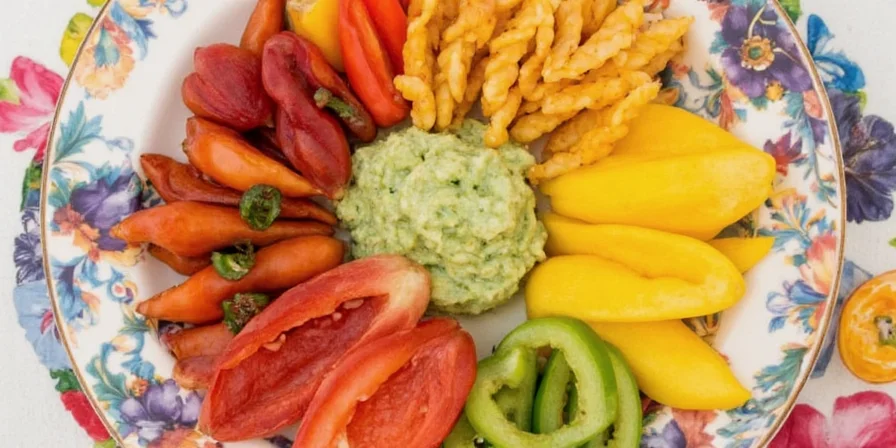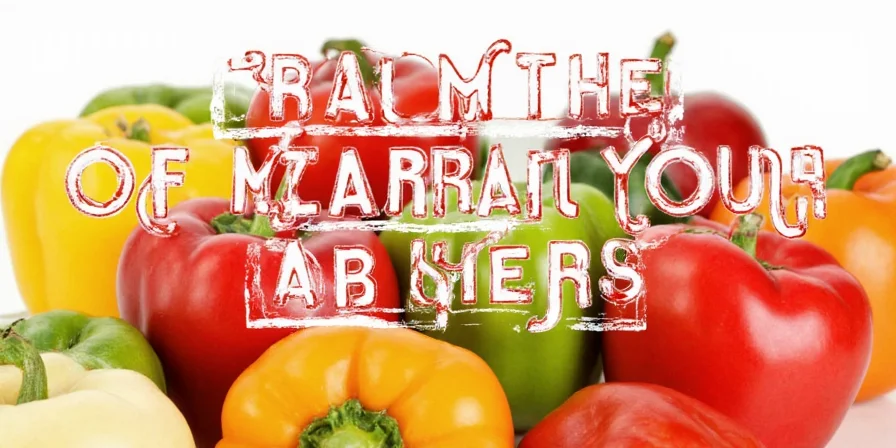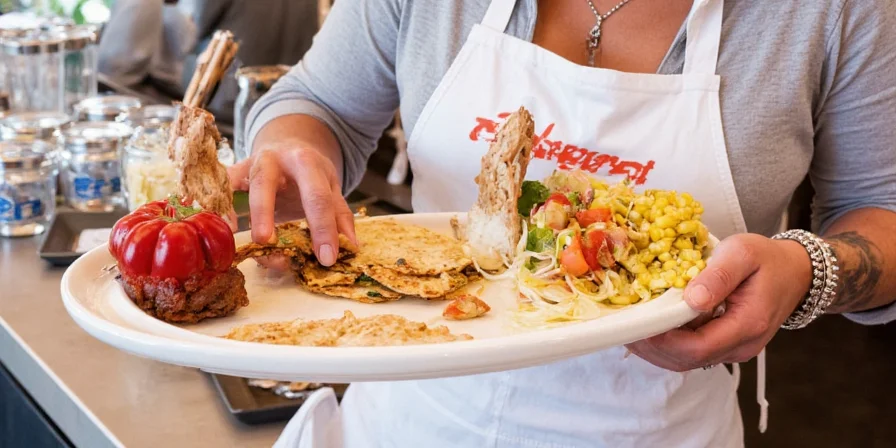When searching for 'Hispanic hot,' you're likely looking for authentic Hispanic spicy foods, hot sauces, or regional chili varieties—not generic heat. This guide cuts through confusion by focusing specifically on traditional Hispanic chili varieties, their cultural significance, and practical usage. Unlike commercial 'Hispanic hot sauce' products found in supermarkets, we explore region-specific chilies that define authentic Latin American cuisine from Mexico to Argentina. You'll discover why genuine Hispanic heat differs from generic spiciness and how to identify authentic products.
This guide targets home cooks and food enthusiasts seeking authentic Hispanic spicy flavors beyond supermarket shortcuts. We address common misunderstandings about 'Hispanic hot' products while providing actionable knowledge for recreating regional dishes. No more guessing: we clarify the difference between authentic regional chilies and commercialized versions you'll find on grocery shelves.
Hispanic Hot: Quick Answers
- What is 'Hispanic hot'? Traditional spicy elements in Latin American cuisine, primarily region-specific chilies (not just heat level)
- Top authentic products: Oaxacan mole paste, Yucatecan recado rojo, Peruvian ají panca
- Avoid: Products labeled simply 'Mexican hot sauce' (usually Americanized versions)
- Key difference: Hispanic heat focuses on flavor integration, not just Scoville units
Table of Contents
- What 'Hispanic Hot' Really Means (Beyond the Hype)
- Authentic Hispanic Chili Varieties: Regional Breakdown
- Hispanic Hot Sauces: Identifying Authentic Products
- From Mild to Wild: Understanding Regional Heat Profiles
- How to Use Hispanic Spices Like a Pro
- Chili Comparison: Authentic Regional Varieties
- DIY Hispanic-Inspired Blends
- Food Pairing Guide for Hispanic Heat
- Common Mistakes with Hispanic Spices
- Cultural Significance of Heat in Hispanic Cuisine
What 'Hispanic Hot' Really Means (Beyond the Hype)
Authentic 'Hispanic hot' refers to region-specific chili varieties and preparation methods used throughout Latin America—not just heat level. Unlike standardized commercial blends, traditional Hispanic heat integrates climate-driven flavor variations: Andean elevation-grown aji peppers develop floral notes absent in lowland varieties, while sun-drying techniques in Guerrero impart smokiness impossible to replicate artificially. Crucially, Hispanic cuisine balances heat with complementary elements—like tomatillo's acidity in salsa verde or plantain's sweetness in Puerto Rican alcapurrias—to create multidimensional profiles.
This regional specificity explains why substituting generic 'chili powder' fails. True depth comes from understanding how Mexican pasilla's raisin-like earthiness differs from Peruvian mirasol's berry tang—knowledge passed through generations, not ingredient lists. When shopping for 'Hispanic hot' products, look for specific regional indicators like 'Oaxaca' or 'Yucatán' on packaging—not just 'Mexican' which often indicates Americanized versions.

Authentic Hispanic Chili Varieties: Regional Breakdown
These foundational chilies define regional cuisines with distinct flavor signatures that go beyond simple heat:
- Ancho Chili – Mexico's 'mole backbone,' with raisin-chocolate notes from sun-dried poblanos. Ideal for complex sauces where heat plays second fiddle to depth. Look for products labeled 'Oaxaca' for authentic versions.
- Guajillo Chili – Central Mexico's secret weapon: thin-walled with cranberry acidity. Essential for adobos where vinegar would overpower. Authentic products specify 'Jalisco' or 'Michoacán' origin.
- Habanero Chili – Yucatan's citrusy firebomb. Never raw; always infused in sour orange for recado rojo to tame its 350,000 SHU intensity. Look for 'Yucatán' designation on authentic products.
| Chili | Authentic Regional Source | Heat Level (SHU) | Flavor Profile |
|---|---|---|---|
| Ancho | Oaxaca, Mexico | 1,000–2,000 | Sweet, raisin-like |
| Guajillo | Jalisco, Mexico | 2,500–5,000 | Tangy, berry-like |
| Habanero | Yucatán, Mexico | 100,000–350,000 | Fruity, floral |
Hispanic Hot Sauces: Identifying Authentic Products
Most 'Hispanic hot' sauces in supermarkets are Americanized versions. Here's how to identify authentic products:
- Check the origin label: Authentic products specify regions (Oaxaca, Yucatán, Peru), not just 'Mexican' or 'Hispanic'
- Examine ingredients: Authentic Hispanic hot sauces use citrus juices (bitter orange, lime) not vinegar as acidifiers
- Watch for regional indicators: 'Recado rojo' (Yucatán), 'mojo de ajo' (Cuba), 'pebre' (Chile)
- Avoid: Products listing 'chili powder' or 'red pepper' as primary ingredients (indicates generic blend)
Top authentic Hispanic hot sauce brands by region:
- Mexico: Valentina (authentic version specifies Jalisco origin), El Yucateco (Yucatán)
- Peru: Ají Panca paste from Lima markets
- Cuba: Original Cristal brand (pre-1960s recipe versions)

From Mild to Wild: Understanding Regional Heat Profiles
Scoville Units alone mislead—Hispanic cooking prioritizes flavor integration over heat dominance. Consider these region-specific applications:
- Mild (Jalapeño): Used fresh in salsas verdes where vegetal notes shine; heat is incidental. Authentic versions come from San Martín Texmelucan, Mexico.
- Medium (Serrano): The backbone of pico de gallo—adds sharpness without overwhelming tomatoes. Look for 'Sinaloa' designation on authentic products.
- Hot (Chiltepin): Gulf Coast secret for seafood—earthy heat complements citrus without overwhelming. Often labeled 'Sonora' on authentic products.
- Extreme (Habanero): Always tempered: Yucatecans soak in bitter orange juice to mellow harshness while preserving fruitiness. Authentic versions specify 'Yucatán.'
How to Use Hispanic Spices Like a Pro
Move beyond basic grinding with these field-tested techniques:
- Rehydrate Strategically: Simmer guajillos in orange juice (not water) to amplify fruity notes for authentic adobo. Look for guajillos labeled 'Jalisco' for best results.
- Seed Removal Precision: For habaneros, scrape membranes with a spoon—seeds contain volatile oils that cause bitter aftertastes. Authentic Yucatecan recipes specify this technique.
- Acid Balance: Use lime zest (not just juice) in salsas; oils in zest brighten heat without diluting flavor. Traditional Mexican cooks never use vinegar in authentic salsas.
- Oil Infusion Timing: Add dried chilies to cold oil, then heat slowly—prevents burnt flavors in recados. Authentic Yucatecan cooks use this method for recado rojo.
- Regional Freshness Hack: Freeze whole dried chilies; condensation during thawing rehydrates without sogginess. Oaxacan mole makers use this technique.
Chili Comparison: Authentic Regional Varieties
Key differentiators for identifying authentic Hispanic hot products:
| Chili | Authentic Regional Source | Flavor Distinction | Authentic Product Indicator |
|---|---|---|---|
| Chipotle | Morelos, Mexico | Smoky-sweet from mesquite wood smoking | 'Méjico' label, not 'Mexican' |
| Pasilla | Puebla, Mexico | Grassy with subtle licorice | 'Puebla' designation on packaging |
| Arbol Chili | Sinaloa, Mexico | Sharp, nutty heat without fruitiness | Sinaloan seafood restaurants use exclusively |
| Ají Panca | Lima, Peru | Berry-like with low heat | Peruvian products specify 'Lima' |

DIY Hispanic-Inspired Blends
Authentic blends require technique, not just ingredients. These ratios mirror regional standards:
True Oaxacan Mole Negro Base
- 3 tbsp ground ancho (labeled 'Oaxaca')
- 1 tbsp ground pasilla (toasted, 'Puebla' origin)
- 1 tsp Mexican cinnamon (Ceylon variety, not cassia)
- 1/2 tsp unsweetened cacao
- 1/4 tsp Mexican oregano (not Mediterranean)
Toast whole chilies 30 sec per side before grinding. Bloom spices in lard—not oil—for authentic texture. Authentic Oaxacan products never use vinegar.
Yucatecan Recado Rojo Paste
- 2 tbsp habanero paste (soaked in bitter orange, labeled 'Yucatán')
- 1 tbsp achiote seeds (toasted)
- 1 tsp allspice berries (freshly ground)
- 1 clove garlic
- 1/2 tsp oregano
Grind into paste with a mortar—never a blender—to preserve essential oils. Use within 24 hours. Authentic versions specify 'México' not 'Mexican.'

Food Pairing Guide for Hispanic Heat
Regional pairing wisdom often ignored in commercial products:
- Seafood: Gulf Coast cooks use chiltepin (labeled 'Sonora') in ceviche—its earthy heat complements citrus without overwhelming. Avoid habanero in authentic seafood applications.
- Beef: Northern Mexico's carne asada relies on chiles de árbol for sharp heat that cuts through fat, never chipotle. Look for 'Sinaloa' designation.
- Vegetables: Andean chuño (freeze-dried potato) requires ají amarillo's floral heat—substitutes ruin texture. Authentic Peruvian products specify 'Lima.'
- Desserts: Authentic Mexican chocolate truffles use ancho powder, not cayenne, for raisin-chocolate synergy. Check for 'Oaxaca' on packaging.
Common Mistakes with Hispanic Spices
Critical errors even experienced cooks make with Hispanic hot products:
- Mistake: Using vinegar in habanero salsa
Solution: Bitter orange juice preserves floral notes; vinegar creates harsh vinegar-bomb effect. Authentic Yucatecan products never contain vinegar. - Mistake: Buying 'Mexican hot sauce' without regional specification
Solution: Look for specific regional designations like 'Oaxaca,' 'Yucatán,' or 'Puebla' for authentic products. - Mistake: Storing in clear jars
Solution: Amber glass blocks UV light; clear jars degrade capsaicin in 6 weeks. Authentic producers use dark glass. - Mistake: Assuming 'mild' means 'weak'
Solution: Jalapeños vary 10x in heat; authentic regional products specify growing location (e.g., 'San Martín Texmelucan').

Cultural Significance of Heat in Hispanic Cuisine
Hispanic chilies tell geographic stories most commercial products ignore. In Oaxaca, mole negro's 23 ingredients—including rare chilhuacle negro—reflect pre-Hispanic trade routes where chilies functioned as currency. Meanwhile, Yucatecan recado rojo's achiote base stems from Maya ritual use (red=lifeblood), not just flavor. Crucially, heat tolerance varies dramatically: Chilean pebre sauce uses mild merkén because Andean altitude reduces capsaicin production, while Caribbean cuisines amplify heat to preserve food in humidity. This isn't 'spicy cooking'—it's cultural adaptation encoded in flavor that authentic Hispanic hot products preserve.
Frequently Asked Questions
How do I identify authentic Hispanic hot sauce products?
Look for specific regional indicators: 'Oaxaca' on mole paste, 'Yucatán' on recado, or 'Peru' on ají panca. Authentic products list single-origin chilies (e.g., 'Jalapeño de San Martín Texmelucan') and avoid vinegar in salsas—citrus juices are traditional. Avoid products labeled simply 'Mexican hot sauce' which are usually Americanized versions.
Why does my store-bought 'Hispanic hot' product taste different from authentic versions?
Most commercial 'Hispanic hot' products are Americanized versions that substitute vinegar for traditional citrus, use generic chili blends instead of region-specific varieties, and prioritize heat over flavor balance. Authentic products specify regions of origin and use traditional preparation methods like sun-drying or mesquite smoking that create distinctive flavor profiles.
Are all Hispanic hot products extremely spicy?
No. Hispanic cuisine emphasizes flavor integration over heat intensity. Many authentic regional products like Peruvian ají panca (berry-like, low heat) or Mexican ancho (sweet, raisin-like) are mild. Heat levels vary dramatically by region—Chilean merkén is mild while Yucatecan habanero-based products are extremely hot. Authentic products reflect these regional differences rather than standardizing heat levels.
What's the difference between Hispanic hot products and regular hot sauces?
Authentic Hispanic hot products focus on regional chili varieties and traditional preparation methods that create distinctive flavor profiles, not just heat. They use citrus juices (bitter orange, lime) instead of vinegar, emphasize flavor balance, and specify regional origins. Commercial hot sauces often standardize heat levels, use generic 'chili powder,' and prioritize burn over nuanced flavor. True Hispanic hot products tell a geographic story through their ingredients and preparation.
Conclusion
Authentic 'Hispanic hot' refers to region-specific chili varieties and preparation methods that create distinctive flavor profiles—not just heat level. By understanding regional differences and traditional techniques, you can identify genuine products that honor cultural heritage. Start by looking for specific regional designations on packaging and avoiding vinegar-based products. Remember, the goal of Hispanic heat isn't maximum spiciness—it's balanced cuisine where heat serves the cultural story on your plate. Whether exploring Oaxacan moles or Yucatecan recados, authentic Hispanic hot products offer a flavorful journey through Latin America's diverse culinary landscape.

Which authentic Hispanic hot product will you try next? Share your discoveries below—we'll help you identify genuine regional specialties!











 浙公网安备
33010002000092号
浙公网安备
33010002000092号 浙B2-20120091-4
浙B2-20120091-4